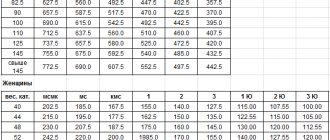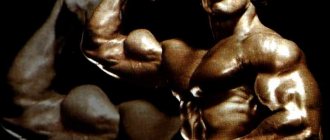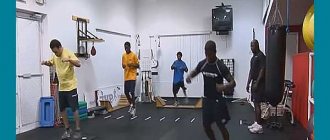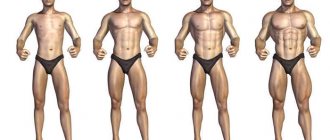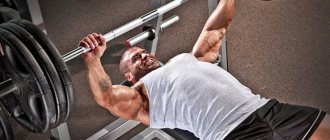Choosing a working weight to perform exercises is one of the key points to a successful workout. A low working weight will not allow the activation of muscle growth mechanisms, and an excessively high one will increase the risk of injury by reducing control over the technique.
In this case, the worst option would be to imitate famous athletes or random people from the gym. If someone does a biceps curl with 20kg dumbbells or bench presses with an 80kg barbell, that doesn't mean you need the same weight.
What is refusal repetition, you ask.
Failure Rep (this is when muscle failure has occurred), muscle failure is the point at which performing an exercise with proper technique for another repetition on your own becomes impossible.
Those. Using the example of lifting a barbell for biceps (I told you above), failure occurs on the eighth repetition, that is, the athlete will no longer be able to handle the ninth. Therefore, this is the working weight.
Well, guys, these are the kind of witnesses that I should have explained at the very beginning, there is still a lot of information that you should know, this is just the beginning of our journey)).
The fact is that working weights in exercises are not static! Those. they, in accordance with the principle of load progression, must constantly change..., I already (in the distant past) ate all the baldness for myself and for you... and today I will eat it again...))), just in case, below I will give a list main articles on load progression (links below):
- Bodybuilding training programs (here, at the very beginning, it tells you step by step and explains how to use safe methods of progression, i.e. increasing weights and repetitions).
- German volumetric training (here we talk again about the same safe methods, but also about an unsafe method of load progression, for professionals).
- Natural bodybuilding muscles without steroids (it tells in principle why progression is needed, how to carry it out, etc., but not as detailed as in the first and second articles).
So, what am I talking about? => Most people (especially novice athletes) simply simply do not understand how to choose the weight for a particular exercise, + even if by some miracle they selected it once (and selected it correctly), then at the next workout it must change again, because, as I already said a little higher, the weight is not static... it must constantly change in accordance with the principle of load progression; if it does not change, muscle growth in principle becomes impossible. This is the dilemma we have to deal with.
Diet rules: when to eat a forbidden piece?
Demonstrating the beauty of an athletic body as a result of strength training is impossible without proper nutrition.
- What sports do you do;
- how frequent and intense the training is;
- body composition;
- purpose of training;
- external environment.
The main condition: the body must receive all the necessary substances for recovery after training. The main source of energy for muscles is glycogen (cereals and nuts do a good job of supplying the body).
Antioxidants contained in vegetables and chicken meat “repair” muscle microtraumas received during intense training. In addition, vegetables saturate the body with moisture.
High protein yogurt will help maintain the required level of casein.
A healthy cocktail containing cherry juice, ginger and a protein mixture is recommended to reduce muscle pain after workouts.
People look different at different years of life. Striving to become a better person and make your body fit and beautiful is a laudable desire. However, you need to do this for yourself, and not for onlookers on the beach. Good luck!
For those of us who are already familiar with bodybuilding first-hand, the question of choosing a suitable working weight seems absurd and simply inappropriate. However, for those who are just beginning their development in this sport, this is the very first question that comes to the mind of a beginner standing in front of an endless rack of dumbbells.
Question: How to choose a working weight for training?
I just started bodybuilding and the very first obstacle I faced was choosing a working weight. How can I determine which weight is best to train with?
Load progression (twenty-five again)
Most people in the gym have no idea what progressive load is; they have been training with the same weights for months, or even years.
Well, for example, an athlete did a bench press of 80 kg a month ago, and bench presses the same 80 kg after the same month or even more. Do you see? No progress!
Therefore, if there is no progression, how will the muscles change? How can they grow? Why should they grow?
Not a damn thing changes, the load doesn’t change (doesn’t increase), and if the load doesn’t change, then why the hell should the muscles change?...
Conclusion: If the load is constant and the same from one workout to another, then the muscles do not grow. Therefore, your trips to the gym are pointless.
The other side of the coin is that increasing weights is one way to progress. One of!!!! Do you understand? In fact, there are many ways to progress. Simply increasing weight = this is the simplest and at the same time understandable way for people.
This is why I and not only me, many trainers recommend that beginner athletes achieve progression of loads through increasing the weight on the barbell, etc., why?
Yes, because it is very difficult to make a mistake, get confused or do something wrong. Do you understand?
Everything is very simple, here you bench press 40 kilograms, then 45, then 50, after a while 60, then 70, 80, 90, 100, etc. Everyone can see that the load is changing. Right? ... I don’t know who and what you have to be in order not to notice this.
But, as I already said, this is one way, and there are a lot of them!!! Now I will explain everything in detail again.
Where to start for beginners
For beginners entering the gym for the first time, everything is simple - take the minimum weight of weights and study the technique of performing the exercises. “Minimum” is one or two 5 kg bars in a block, 1-2 kg pink dumbbells or a 12, 15 or 20 kg barbell, or you can start with a six-kilogram bodybar and you don’t have to be shy. In the end, both your health and further progress in training depend on how well you perform the exercise technique.
On the other hand, the question arises - what prevents you from using equipment with a slightly larger weight, if it is very easy for a person to lift a barbell? Nothing stands in the way - go ahead and sing! Moreover, some idiot coaches practice such a method as “load the beginner harder to understand his strength capabilities.” At the same time, an inexperienced friend will think that the training went well if he cannot straighten up in the morning after the gym and cannot get up from the toilet without outside help. It just doesn't end well in the end.
The fact is that with a relatively large weight of weight, it is almost impossible to learn how to do the movement correctly. You're just trying to somehow squeeze the weight, just to beat it - bending and squirming under the bar like crazy.
At the same time, with a minimum weight it is quite easy to work in the correct amplitude and, most importantly, remember the movement! Yes, yes - just remember. The more you repeat the movement, the better you will remember and eventually you will perform it correctly automatically, without thinking and regardless of the weight of the burden, even if you have your maximum maximum in your hands.
When you just start learning this or that exercise, your head is loaded no less than your muscles. Let’s say that in a bench press you think about keeping your shoulder blades together, the bar lying on the base of your palms, smoothly lowering to the middle of your chest with a touch, and not fully extending your arms when lifting (do not insert your elbows). At the same time, the barbell “storms and chatters” from side to side, because the stabilizer muscles are not yet accustomed to such work, and it is difficult for the brain to send a synchronous impulse to both hands - a new activity for it.
Another example is squats with a barbell on your shoulders: you keep your lower back arched, tense your abs (keep your stomach pulled in), carefully squat, moving your pelvis back if necessary and leaning forward a little so that your knees do not go beyond the line of your toes, then you smoothly stand up, but at the end You don’t fully extend your leg movements (you don’t put your knees in), then you repeat the movement again. Again, it is difficult to perform the exercise correctly the first time, and you also need to choose a comfortable position for the legs, decide on the movement itself, taking into account the length of the thighs and lower legs, etc. Naturally, if you load the barbell right away, it is impossible to do all this.
Working with minimal weight and the correct range of motion, the more times you repeat the movement, the better you will perform it. The cerebellum is responsible for this - it remembers which motor units and in what sequence need to be used under certain conditions, and as a result, the movement will be performed automatically without additional control on your part. In addition, in the process, the brain looks for ways to perform the movement most effectively, taking into account your own structure. After all, we are all different, different levers, muscle attachments, etc. If you try to learn a technique with heavy weights, then there is a high chance of “training” the cerebellum for incorrect movement, which ultimately can lead to injury.
By the way, the “Blind typing method” is studied in exactly the same way - the cerebellum “remembers” its movement for each finger and, as a result, there is no need to control the hands. All your thoughts are instantly transferred into text without having to look at the keyboard and think about the typing process. Actually, this is how I type this text.
Remember the practices of martial arts, when in order to study a particular technique and strike it is necessary to repeat the movement hundreds, or even thousands of times, to develop complete automatism. This all works for gym exercises too.
Load progression methods
- Well, first of all, (I repeat) this is an increase in weight (on a barbell, dumbbells, machines, etc.) = a safe way.
- Secondly, increasing the number of repetitions in an exercise = the same safe way.
- Thirdly, increasing the total volume of load per workout (here we mean increasing the number of approaches in each exercise or increasing the number of exercises per workout, or even both by reducing rest between approaches) = unsafe method (for professionals ).
- Other ways to increase training intensity (supersets, drop sets, giant sets, forced reps, negative reps, etc.) = unsafe method (for advanced ones).
These are the main ways to progress the load.
But! For most people training in the gym, the main way to progress the load is to use an increase in weights + number of repetitions (within the necessary limits), because this guarantees muscle growth on the one hand, and is safe for your muscles and body, on the other hand. .
Ps I, like most people, constantly use these 2 methods (well, I also use other methods of increasing the intensity of training), but it took me a very long time to get to this point, for many years (2-3 years) I only used the first 2 methods, and only then slowly began to connect drop sets, supersets, etc.
I also tried the third method (increasing the volume of load per workout) (for some time) = it is very, very, and again very difficult (especially if you train without a trainer), I was forced to quit, simply because it is for professionals. I am not a professional, I do not compete, etc. I'm happy with everything anyway.
I hope I didn’t write this paragraph in vain and you caught the essence of what I said.
Rest between sets.
Rest between sets
in the exercise should be exactly 5 minutes if you did a heavy basic exercise. Previously, the muscles simply will not have time to recover. There is no need to listen to advisers who will say that you need to rest for 2 minutes or even 30 seconds.
These numbers come from chemists (guys who use anabolic steroids). Their muscles actually recover faster. But a pure athlete needs to rest for 5 minutes in order to perform the next approach efficiently.
And I want to note that you should not rest for more than 7 minutes. After this, the muscles cool down and additional warm-up may be necessary, which is absolutely unnecessary. If the exercise is light and isolated, then you can take a break of 3-4 minutes, but not two.
How to determine how many approaches you need to do in an exercise? And how to start so that you don’t get sick?
So how do you determine what weight to use for an exercise?
Now that you know about the progression of the load (namely, about the safe methods, this is the 1st increase in weights and the 2nd increase in the number of repetitions), you can talk about how to determine what weight to use in a particular exercise. Now I will explain everything in detail.
Increasing weight and number of repetitions per set = these are two parameters that are inversely related.
What do you mean, you ask. The point is, in order to choose what working weight to use in an exercise, you must first decide how many repetitions you will do (in that same exercise).
After all, you can do 1 or 2 repetitions, you can do 4, you can do 6, you can do 8, you can do 10, you can do all 30.
Remember, to gain lean body mass (muscle gain) = optimal number of repetitions = 6-12 repetitions!!!! <= this is a long topic (for an explanation of why exactly 6-12, read the article => “How many repetitions should you do in a set?”).
In short, this is the number of repetitions that ensures the required time for our muscles to be under load (and the time under load should be 7-30 seconds), if there are fewer repetitions, strength will increase (muscles will not grow), and if there are more repetitions - endurance will increase (muscles will not grow either). Do you understand?
That is why in most cases (exercises) you need to do just that many repetitions for muscle growth, with the exception of exercises with a very short range of motion, for example, such as: “Standing calf raise”, “Seated calf raise” and some others.
Conclusion: for muscle growth, the best number of repetitions is from 6 to 12.
The next important point concerns muscle failure (I told you about this at the very beginning of the article), so we found out that 6-12 repetitions are best for muscle growth, therefore, failure (muscles) = should occur in this repetition range ( 6-12).
This is very important to understand, the fact is that you can essentially do 30 repetitions, but you specifically stop within 6-12 repetitions (because you read my article and did not understand it correctly), in this case due to the fact that that the load is very light, the muscles will not grow, your endurance will grow, not the muscles, in order for the muscles to grow, we need to choose a weight so that you can do at least 6 repetitions and no more than 12. Do you understand?
If you can do more than 12 = this is no longer a working weight, you have gone beyond what is allowed, add more weight so that you do not go beyond these limits (6-12 repetitions)!!!!
Another important point, this working weight (I also talked about this at the beginning of the article) will be individual for everyone!
This is why experienced athletes are at a loss when asking what the weight should be in an exercise when beginners ask them this, because such questions seem absurd and simply inappropriate, because all this is strictly individual for each person because:
- Everyone has different levels of training (training experience)
- Everyone has different rest periods between sets.
- everyone has a different technique for performing the exercise (some work with the main target muscles, while others haphazardly connect more and more secondary ones)
- Everyone has a different pace of doing exercises (some do it quickly, some do it slowly, some do it in the middle)
Conclusion: the weight on the bar is always individual, you cannot say how much you or someone else should lift the weight. Because it all depends on your individual characteristics (I talked about this above, re-read). And you need to select the weight so that failure occurs within the required repetition limit (namely 6-12 repetitions).
By the way: I highly recommend studying my books:
How to increase in training
When you don’t feel a surge of strength for a long time, and your results remain at the same level, this means one thing - you have reached a plateau in your capabilities. Strength is not growing, there is no progress, the mood is disgusting.
What to do? Be patient and keep training. Let the weights be the same, no problem. If you want, try increasing them by 0.5 kg, at a minimum. If you can't bear it at all, take a break for 1-2 weeks. Take up other sports, walk more, listen to your favorite music and allow yourself to enjoy life!
Also analyze your life. Maybe it’s not about sports, perhaps there are other reasons for frustration and poor health?
Selection of initial working weight
Okay, let's move on to practice, how to choose the right initial working weight, for example, using the exercise “Leg press in a machine” as an example? This is just an example (I chose the exercise in random order, you will conduct experiments on yourself with all the exercises) in order to find out what working weight to use in this or that exercise. Is it clear what we're talking about?
And so we remember, yes, we need failure to occur in the range of 6-12 repetitions.
We put the weight (in the leg press) at twenty on each side (i.e. 40 kilograms) and try to complete 10 repetitions! Next see:
If you managed to complete all 10 repetitions (i.e., failure did not occur), then we add more weight (because the load is too small, failure did not occur within 6-12 repetitions).
We add weight, namely another 5-10 kilograms or more, see for yourself depending on the situation (but in this example, i.e. 5-10 kilograms, remember, if it was difficult for you to squeeze the platform on the tenth repetition, then add 5 kilograms, if relatively easy, = then feel free to hang tens), i.e. in the end it turns out to be 50-60 kilograms (or more, depending on how many pancakes you hung).
So, again (we test) doing 10 repetitions, if again we managed to do everything 10 times, then we add weight again!!! Those. another 5-10 kilograms (or more, but depending on how you feel) in the end it’s already 70-80 kilograms, we try to do it 10 times, and if you were unable to complete all ten repetitions, and failure occurred on the 8th or 9th, then everything is ok, you have chosen the right working weight (you have succeeded).
Those. Is the principle clear? We set some average weight and start testing, if you have done 10 repetitions, add more weight, more and more until you can do 10 repetitions (i.e. failure should occur within 6-12 repetitions).
After you do this testing, you will know what your working weight is in a particular exercise!!! Do you understand? This is done once (in order to find out what working weights you have in a particular exercise), at the next training session you will no longer carry out these tests, you will immediately work with working weights, that is, with such weights that will best grow your muscles. muscles, and all because muscle failure will occur within the required limit (7-30 seconds) due to the required repetition limit (6-12).
You will suffer at first (while you test), but then everything will be as it should..
I really hope that you understood the essence of the method, because it is so important.
Ok, after we have selected the initial working weight, what should we do next?
After all, it needs to be added from workout to workout, how to do this? Read on.
Muscle tone for girls
Girls without experience in strength training should try a light weight first. With it, try to learn to feel the work of those muscle groups that the exercise is aimed at. Gradually develop the technique of movements, and then increase the weight.
Most representatives of the fair sex are more comfortable training for relief. There is a physiological explanation for this. “It’s much more difficult for girls to gain muscle mass than for men,” says Olga Novikova. “Everything is determined by our physiology: hormonal levels, the structure of the musculoskeletal system, the ratio of fat and muscle, endurance, which is higher in girls than in men. Therefore, in training for women, the working weight will be less and the number of repetitions will be higher.”
This explains the popularity of power aerobics among women.
Selection of subsequent weight (with progressive load)
Now I will show you the whole scheme for selecting working weight in practice using the very safe methods of load progression (1st method increasing weights, 2nd method increasing repetitions), in the exercise bench press on an inclined bench. Read carefully!!!
1st method. Let's say on Monday you work on an incline bench press of 50 kg for 6 reps, this means that in the next workout (next Monday), you are required to do 50 kg for 7 or 8 or 9 or 10 reps (depending on your strength ).
In any case, if you have done one or two or three more repetitions than the previous one, then your task is completed.
Conclusion: That week it was 50 kg for 6 times, this week it’s already 7 times or 8 or 10 (depending on how much you got) = progression of load = muscle growth.
2nd method. Okay, we're up to 12 reps on the incline press.
That is 50 kg for 12 times. The next progression will be to increase the working weight, not the repetitions.
That is: 52 kg for 6-12 repetitions, you see it’s no longer 50, already 52 = progression of weights (so, let’s say it turned out to be 52 kg for 8 repetitions, we again use the 1st method of progression - repetitions), we do 52 kg not for 8, and already at 12, then again we use the 2nd method and increase the weight = 54 kg by 6-12 (etc.). I think you get the point.
We did less than 12 repetitions (let’s say there are 10 repetitions, we use the 1st method and increase the repetitions), as soon as we reach 12 repetitions we increase the weight (2nd method). Oh, and one more thing, you should use progressive loads (both methods) in all exercises, not just the bench press (this is just an example for you).
Determining the maximum
“First you need to find the maximum weight for you, that is, the weight with which you can do just one repetition,” explains Olga Novikova. - In different exercises, this weight will naturally be different. For example, if you put a 10kg barbell on your shoulders and can only squat it once, then 10kg is your maximum shoulder squat weight. And all further training is based on it.”
It is better to determine the maximum weight not alone, but with a coach or an experienced athlete. After all, you can overestimate your strength (more often this applies to men), then insurance from a partner will help you complete the exercise without injury.
3. Pace of execution
Another factor influencing the results is the speed of movement. For example, you see this indication: 4-1-X-1. The first number indicates the eccentric, or negative, phase (lowering of the projectile), that is, the downward movement lasts 4 seconds. The second number is a pause at the bottom point. The next symbol describes the concentric phase (rise), the "X" is used to indicate the maximum possible speed. And the last number is a pause at the top point. If you want more muscles, then at this second contract them further; if your goal is strength, then just take a breath. A few additional comments on each phase.
Eccentric phase It is very important for bodybuilders because... significantly stimulates muscle growth. However, for strength athletes, the negative phase can be too “negative” - it can lead to an increase in post-workout pain. This is not a problem if you squat in a bodybuilding program once a week. But for strength athletes who need to train squats 2-4 times a week, constant soreness clearly does not help.
Pause at the lowest point It can be useful for everyone. Bodybuilders use it to fully stretch working muscles and increase range of motion. Powerlifters linger there to strengthen the movement from the bottom point, eliminating the rebound.
Concentric Phase In powerlifting, you only need one speed - maximum speed. Of course, when you have a couple of hundredweight on your shoulders, the movement will not look too fast, but you should try to rise faster. Slowing down the concentric or eccentric phase is not as beneficial in powerlifting as it is in bodybuilding.
Pause at the top As I said, bodybuilders should contract their muscles at the top. It helps with hypertrophy and improves neuromuscular communication (brain-muscle connection). It is better for powerlifters to simply rest, saving their strength for high-quality performance of the next repetition.



